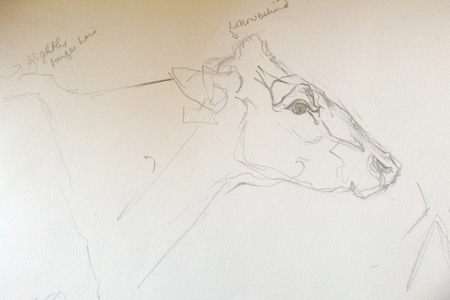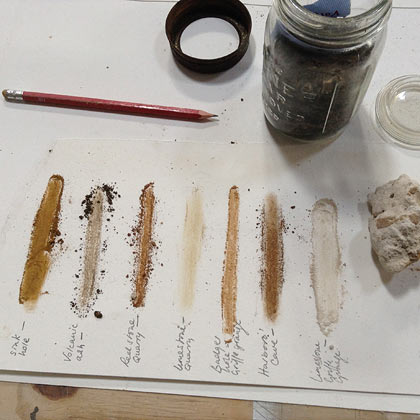Blog: Sally Matthews
Cow sculpture in progress!

The armature for the diary cow sculpture for Hill
Cows
Three days drawing the cows. Too cold to draw for long each day but great to spend time with them. A few were quite friendly and wanted to be scratched: it was good to feel over their different shaped bodies. Got them in my head now to hopefully start the sculpture soon. Loads of sketches for knowledge gathering.


Sheep's Hooves
In the process of attaching wooden sheep's hooves to the metal frame of our "thought sheep". See you at Celebrate Middleton!

Lambing
Drawing the ewes lambing you can see the milking cows walking past the gap in the wall between the two sheds.
BLACK and WHITE walking back from being milked. I was concentrating on the lambing ewes but the black and white is so pure and incongruous it was difficult not to be drawn to them.They are Freisian cows,chosen by Ian's family as they are a cattle that can thrive on upland grass unlike the more modern Holstein.
'The exact origins of the breed are difficult to determine but it is known that in the 18th century, herds of small black-and-white cattle were brought into northern Holland and Friesland from northern Jutland to replace animals that had fallen victim to disease and flooding.'
SPRING GRASS Ian had just let them out onto the green fields for summer grazing. The fields are surrounded by stone walls. stone balancing on stone.
In the studio I am thinking again about the dairy cows. The dairy industry has a long history in Derbyshire. the Midland trains bringing the milk to London. MILK TRAINS.
Looking at some old geological and agricultural maps of the area I have been trying the limestone against some coal for a dairy cow sculpture.
Black gloss paint and Gesso for some big drawings.
COAL and LIMESTONE. BLACK and WHITE
 BLACK GLOSS and GESSO
BLACK GLOSS and GESSO
 LIMESTONE and COAL
LIMESTONE and COAL

Lambing
My hands are cold. It's early morning and the sun hasn't been up long enough to warm the lambing shed. Ian Lomas has been working all night with his ewes and lambs and looks tired but he had a good night. The ewes are quiet, lying like scattered grains of rice across the straw. There is only the sound of chewing and lambs and ewes talking to each other.
I try to do lots of quick drawings - learning the sheep's form and movement rather than trying to get good sketches. On the third day the sketches are getting better as the sheep are in my head now - seeing their heads when I close my eyes.
There are two ewes lambing - a single - and one that is having triplets - a blue mark on the middle of her back indicates she is going to have three lambs. I sit on a water trough to draw her. It's difficult as she is moving a lot. She is up checking and pawing the ground and down throwing her head back, straining. The two front hooves of the first lamb are coming out facing down so it should be an easy birth. I draw a sheep that's lying near to us for a while until the lambing ewe settles for a moment to lick her new born lamb.


Materials from the Hill
I am looking for hares in the rough grass amongst the stones on the top fields at Griffe Walk but it's not early enough or I'm just not lucky enough to see them this morning. From here you can look across to Longcliffe Quarry - a huge scar where the wild upland has been cut away to reveal the limestone. The layers of white and ochre colours of the quarry wall are the colours of the sheep and tracks laid down between the stone walls of the small surrounding fields. I have collected some limestone to see if it will make a sheep sculpture or the white patches of the dairy cows. The limestone under their feet growing the grass they eat.
The colours of the earth here are uncovered by the quarry men,rabbits, badgers, sheep hollows in banks, and landslips. Kate's son and his friend have showed me the grey sticky layer in a stone face - a thin and missable layer,deep down, of volcanic ash from a distant time.

Samples from the Hill


Collecting the samples

Pigments
Read the latest blog posts by